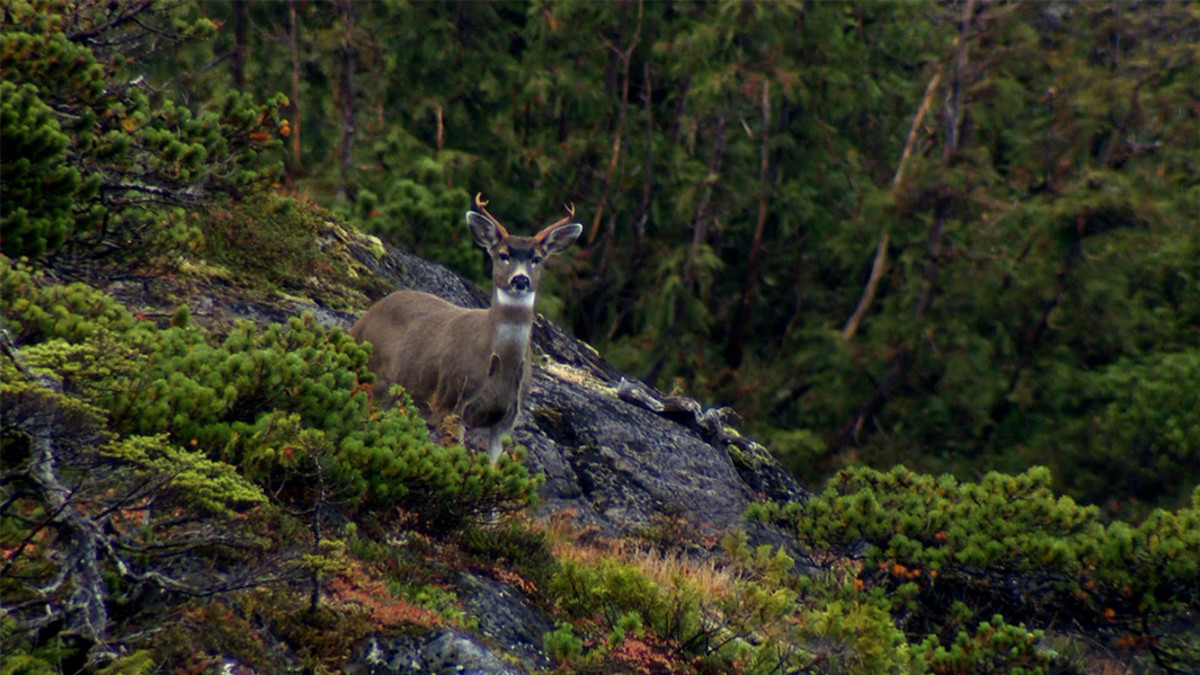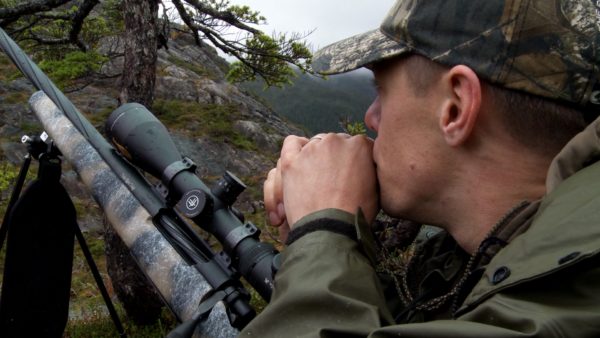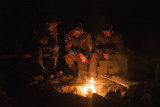
Blacktail deer have a presence of that only rivaled by a ghost. They are there, within the blink of an eye they have vanished, never to show their whereabouts again.
A blacktail deer’s greatest defense strategy is its own home. When faced with even the slightest hunting pressure, blacktail deer simply vanish into the thick coniferous rainforests of their coastal habitats. There, these small deer are protected by seemingly impenetrable vegetation, copious amounts of rain, and fog blanks that are capable of persisting for days on end.
Hunters often refer to the deer as ghosts of the forest, and for good reason. The smart ones emerge from hiding only in the last moments of shooting light and return to their haunts within minutes of daybreak. But blacktail deer are not without vulnerability. They are homebodies, and will often live their entire lives in an area of just a few square miles. When you’ve identified the whereabouts of a blacktail buck, hunting for him should be a quiet, touch-and-go pursuit; the word “delicate” does not overemphasize the point.
To glimpse one of these bucks at close range as he navigates his dark world of ferns, moss, and giant timber is a privilege you will want to remember. And if you’re skillful and lucky enough to kill him, you’ll be thankful to have a freezer full of steaks and roasts to serve as vivid reminders.
Scientific Name
Odocoileous hemionus columbianus and Odocoileous hemionus sitkensis
A.K.A.
There are two recognized forms of blacktail deer, Columbia blacktail and Sitka blacktail. The transition zone between the two varieties occurs in British Columbia, with Columbia blacktails to the south and Sitka blacktails to the north. Both are considered to be mule deer subspecies, though blacktail deer are genetically much older than mule deer. Mule deer developed as a hybridized species between blacktail deer and whitetail deer, probably on the Rocky Mountain front.
Bar Room Banter
Across much of their range, but particularly in the north, blacktail deer are reliant on mixed old growth forests for wintering habitat. Not only does an old growth canopy trap snow that would otherwise bury winter feed, it also lets through enough sunlight to enable the growth of a mixed and vibrant understory of edible plants.
While, in which sunlight can no longer penetrate to the forest floor, understory growth is greatly inhibited. Unless there are newer clearcuts for the deer to migrate to, the animals face an increased risk of malnourishment and predation. There’s almost certainly a correlation between malnourishment and predation, as starving animals are easier for predators to catch. But another factor is at play as well: former clear cuts seem to encourage higher than usual concentrations of black bears, and black bears are a primary predator of blacktail fawns.
Physical Characteristics
Coloration ranges from reddish brown in summer to grayish brown in winter. In comparison to mule deer, blacktail deer have less white on their rumps, more black on their tails, and have shorter ears. There are noticeable physical differences between Columbia blacktail deer and Sitka blacktail deer. For one thing, Columbia blacktail deer achieve larger sizes than Sitka blacktail deer; a big Columbia blacktail buck can weigh well over 150 pounds, while a Sitka blacktail buck will seldom achieve this stature.
Another difference is physical shape. Sitka blacktails have a strong physical resemblance to whitetail deer, while Columbia blacktails have an appearance that seems more aligned with mule deer. The antlers of Columbia blacktail bucks are bifurcated, meaning the tines fork rather than grow singly off a main beam. Sitka blacktail bucks have antler growth that is more similar to whitetail bucks, with unforked tines extending from a main beam.
Diet
Blacktail deer eat a great variety of grasses, forbs, lichens, shrubs, and trees, including salal, Western red cedar, willow, salmonberry, red alder, and even poison oak.
Life and Death
Primary predators include black bears, coyotes, wolves, and mountain lions. Blacktail deer can live up to ten years in the wild but seldom make it past six years of age.
Breeding and Reproduction
Blacktail deer rut in November and early December. Their gestation period is 180 to 200 days. Does drop their fawns, typically one or two, in May or June.
Habitat
Blacktails are common to coastal areas with wet, temperate climates. They frequent “edge” habitats where stands of heavy timber meet meadows, clearings, shorelines, clearcuts, and brushy slopes. Unlike mule deer, which are prone to long seasonal migrations, blacktail deer make only relatively minor shifts in elevation to avoid heavy accumulations of snow.
Telltale Sign
Blacktail deer sign resembles sign left by whitetail deer in similar heavily forested habitats. Besides tracks and scat, look for narrow trails as well as rubs and beds. The beds are about 2’ wide and 3’ long, sometimes consisting of little more than an area of matted ferns and mosses on finger ridges or just below the crests of primary ridges.
Edibility
Excellent and mild, one of the best big game species. Suitable for all red meat applications.
Hunting Opportunities
Because of low hunter success rates and relatively limited hunter interest (due in large part to the thick, wet environments frequented by blacktail deer) tags are fairly easy to acquire in those states that have blacktails. Alaska has some outstanding blacktail opportunities, including many areas where you can legally harvest more than one buck.
Hunting Methods
Spot and stalk hunting for blacktail deer might sound like an impossible dream for hunters living in western Washington and Oregon, where thick timber, underbrush, and overgrown clearcuts rule out the possibility of seeing animals at any appreciable distance.
In other portions of the animal’s range, particularly in northern California and coastal Alaska, spot and stalk is one of the primary strategies used by successful blacktail hunters. In Alaska, it’s particularly effective for late-August and September hunts, when blacktail deer tend to congregate and feed in the sub-alpine and alpine zones above 2,000 feet. These altitudes can be reached in a matter of hours by physically fit hunters starting out at sea-level.
Thanks to the reddish color of the deer’s hair at this time of year, the animals can be ridiculously easy to locate when feeding out in the open against a backdrop of knee-high, vibrant green vegetation. Your best bet in such circumstances is to watch for fresh tracks and trails as you enter the alpine.
Once you’ve established that animals are using the area, find a good vantage point. Ideally you’ll be looking down into areas of mixed timber and alpine muskeg and also up toward surrounding peaks and slopes with brushy avalanche slides and grassy basins. Once you locate a deer that you want, you should take extra time to mark the animal’s location and draw as many navigational references as possible from surrounding features.
Rather than charging directly toward a deer you’ve located, it’s smart to head to a secondary vantage point that lies downwind of the deer’s general location and within rifle range. Once you arrive at that point, make sure that you can see the general area where the deer was hanging out, and verify that it’s within reasonable shooting distance.
If your vantage point is good, one of two things will happen. You’ll either see the deer and make your shot, or you won’t see the deer and you’ll hunker in for the waiting game. If the latter happens, don’t rush it. Blacktail deer will hang around a particular spot for days on end if they’re undisturbed. It’s better to pull back and try again the next day rather than bust into the deer’s home area and spook it out of the country. For archery hunters, a secondary vantage point should be used in order to fine-tune your plans for a final stalk that will hopefully deliver you into bow range.
Spot and stalk situations in California are a bit different, as you’re not always hunting alpine zones. Rather, you’re looking at country comprised of open grasslands and agricultural areas interspersed with tight brushy draws and timbered slopes. But the same principles still apply. Once you’ve verified the presence of deer through scouting, it’s best to hang back and watch for the animals from afar rather than disturb them by trying to violate their sanctuaries. Concentrate your glassing efforts on edge and fringe habitats, where multiple features such as feeding areas and bedding areas come together.
Glassing
Be particularly vigilant about glassing during the first and last minutes of daylight, as pressured blacktails are notorious for going nocturnal when faced with the extra disturbances that come with hunting season. During the midday, it’s wise to use your optics to pick apart the slopes used by bedding deer. During cold weather, the deer will stick to slopes that get sun; during hot weather, they’ll use shaded slopes.
Glass beneath every tree, and into every little nook and cranny where you can see through the overhead canopy. When an animal is located, take the necessary time to identify a potential shooting positions where you can sneak into range without crowding the deer and alerting it. Remember, blacktail deer tend to be homebodies. Take advantage of that fact. If things aren’t perfect, back out and try again another time.
Still Hunting
In areas where glassing long distances is out of the question due to thick vegetation, still hunting for blacktail deer is often the most productive strategy. Many hunters focus almost exclusively on still-hunting along gated or otherwise inactive logging roads that wind their way through networks of early succession clearcuts that provide an abundance of young browse plants that are favored by blacktails. The advantage to this is the relative silence and easy walking afforded by having a wide trail that’s clear of clothes-snagging brush and snapping twigs that might otherwise send these animals heading toward thick cover.
You want to approach each opening and clearcut slowly and carefully, and give them a thorough examination with binoculars before you enter. In good country, you should seldom find yourself taking more than ten steps without raising your binoculars to study the surrounding areas. Because blacktail deer are masters at hiding, keep in mind that you’re not just looking for deer that are 100 yards away; you’re also looking for deer that might be watching you pass by from a distance of 20 yards.
In high-pressure areas, particularly near large urban centers, productive clearcuts get so hammered by competition that serious hunters ignore them altogether in favor of still hunting in heavily timbered areas that are hard for other hunters to access because of a lack of roads, difficult terrain, or questionable property boundaries. Here, the trick is to move slowly and silently along deer trails that show evidence of recent use, particularly in the form of fresh tracks and scat.
The most productive times are those when deer are naturally on the move, as the animals will be close to their trails and they’ll be expecting to see and hear movements from other animals as well. The first couple hours of the day and the last couple hours are the best. It’s even better during periods of drizzle and heavy cloud cover, or in the wake of a heavy rain. While still-hunting, behave as though you’re actively stalking a deer rather than walking in the woods.
Obey the Wind
The most important thing is to obey the wind. Hunt into the wind, or perpendicular to it. Swap out your heavy hiking boots for softer-soled trail runners or stalking slippers to increase your level of stealth. And keep your upper body movements to a minimum. When passing through areas where noise is unavoidable, do so quickly and then hunker down to wait and watch before you begin moving again.
Direct your travel so that you pass through likely feeding areas such as forest openings, small meadows, and, in the north, muskegs. Hug the edges of these openings rather than trudging right through the middle of them. When you stop, which should be often, do so in places where the surrounding vegetation works to mask your outline. To make this system work, you do have to stop often and sometimes for lengthy periods of time to study your surroundings. Look carefully and listen carefully.
Don’t be afraid to pause for ten, fifteen minutes when you reach an area that seems like prime feeding habitat. And remember, you’re not necessarily looking for a whole deer. Rather, you’re more likely to see just a portion of a deer, an ear, an antler, a patch of hair, a leg. A cautious, alert hunter will sometimes hear a deer before the deer hears him. Or the hunter will catch a glimpse of movement from a deer before the deer sees him.
But more often than not, the still-hunter will encounter deer that are aware of his presence though not totally sure about it. The animal will be waiting and watching for a telltale noise or smell that says “human.” If you’re careful and a bit lucky, the deer will not get this verification until it’s too late. And when that verification does come, it should come in the form of a well-placed shot.
Ambush Hunting
Ambush hunting is not associated with blacktail deer in the minds of many hunters, but some of the best blacktail hunters in the country swear by it. One of the greatest advantages to this strategy is that you’re likely to get closer and longer looks at a species of deer that seems almost magical in its ability to escape our attention.
Blacktails are best ambushed from tree stands. Rather than agricultural fields that are so familiar to hunters who target whitetail deer from tree stands in the East, blacktail hunters along the West Coast typically hunt near well-used deer trails in terrain that is often brushy or heavily timbered.
The best trails are those connecting bedding areas and feeding areas. Because blacktail deer travel relatively short distances between their bedding and feeding areas, ideal ambush sites are quite close to bedding areas – sometimes just a hundred or so yards away. At greater distances from bedding areas, the trails often branch out and grow diffuse. And because of the blacktail deer’s habit of becoming nocturnal during hunting season, these more distant portions of trails might not see any buck activity at all until well after dark.
In areas that appear at first glance to lack heavily traveled and clearly identifiable trails, or that lack easily identifiable bedding and feeding areas, try searching for trails near topographical features that might serve to funnel the movements of deer. Such natural funnels might include primary ridgelines that divide drainages, finger ridges that branch off from primary ridges and drop down into canyons or valleys, and even passages between rock outcroppings or along the bases of cliff faces. Such simple features might be all that it takes to concentrate deer traffic in a predictable way.

Keep in mind, too, that stand placement is crucial with blacktail deer, particularly for archery hunters. Don’t necessarily worry about placing your stand where you can see the maximum amount of surrounding country. Blacktails tend to be loyal to their trail systems; unless they’re spooked, they will generally stick to the easy traveling.
It’s better to have a clear view of a well-used trail, with multiple possible shooting lanes, than a view of a bunch of areas that lie outside of your comfortable shooting range. When wind conditions are unfavorable, either blowing the wrong direction or swirling unpredictably, either move your stand or go hunt in an altogether different location. It’s not worth spooking a deer and ruining a good location just to spend an unproductive evening in your stand. In other words, think long term instead of short term.
Calling
Fawn bleats can be very effective for calling blacktail deer, particularly Sitka blacktails. The calls will excite and attract does year round, but during the November rut, the annual breeding frenzy, they can be deadly against bucks as well. Typically, fawn bleat calls are employed by hunters using still-hunting strategies.
Basically, a hunter will make a few calls from a likely position and then wait for a response. If nothing happens, he’ll move along quietly toward a new position a few hundred yards away and try again. Often, a call will do little more than cause nearby deer to stand up at attention but even this limited response gives the hunter a huge advantage in the typically thick cover of blacktail country, where it’s possible to pass within yards of a deer without seeing it.
At other times, the response from a deer can be dramatic and sudden. During the rut, bucks sometimes come in aggressively to the calls, stomping and circling and providing multiple shot opportunities. As it is with most animal calls, blacktail fawn bleats work best on deer that have not yet heard artificially produced calls.
This helps explain why the calls are so much more effective on Sitka blacktails than Columbia blacktails. In Southeast Alaska, where the calls work especially well, there are literally hundreds of mountains—and even entire islands—that commonly go years or even decades without being visited by a hunter. There are deer in these places that have never laid eyes or ears on a human, and never will.






Conversation